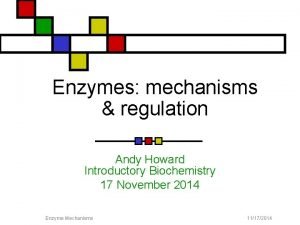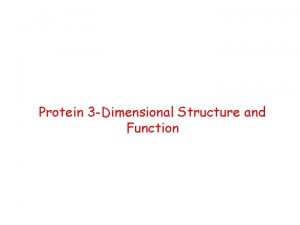Proline Isomerase Pin 1 represses terminal differentiation and

- Slides: 1

Proline Isomerase Pin 1 represses terminal differentiation and Myocyte Enhancer Factor 2 C function in Skeletal Muscle Cells Alessandro Magli*°, Massimo Ganassi*, Fiorenza Baruffaldi*, Sara Badodi*, Cecilia Angelelli*, Renata Battini*, Giannino Del Sal**, Susanna Molinari* *Department of Biomedical Sciences, University of Modena and Reggio Emilia, Via Campi 287, 41100, Modena, Italy. E-mail: molinari. susanna@unimore. it °present address: Lillehei Heart Institute and Dept. of Medicine University of Minnesota, Minneapolis, MN 55455, **Laboratorio Nazionale CIB, Area Science Park, University of Trieste, 34100 Trieste, Italy. This work is supported with grants from the EU programme Optistem and from the Fondazione Cassa di Risparmio di Modena. This work is dedicated to the memory and legacy of our friend Stefano Ferrari who recently passed away. ABSTRACT. MEF 2 (myocyte enhancer factor 2) transcription factors (MEF 2 A-D) are highly Pin 1 IS EXPRESSED IN MUSCLE CELLS AND IS SUBJECTED TO FUNCTIONAL DOMAINS OF Pin 1 expressed in skeletal muscle cells, they bind to a conserved AT rich DNA sequence through NUCLEAR-TO-CYTOPLASM their N-ter MADS and MEF 2 domains and activate transcription via their C-ter transcriptional TRANSLOCATION DURING MUSCLE DIFFERENTIATIONITS A activation domains (TAD), the functional domains of MEF 2 C are indicated in Figure 1. MEF 2 0 proteins interact with members of the Myo. D family of basic helix–loop–helix (b. HLH) proteins to 60 120 W 34 establish a unique transcriptional code for skeletal muscle gene activation. Recent studies have C 113 NH 2 revealed multiple signaling systems that stimulate and inhibit myogenesis by altering MEF 2 isomerase, which catalyzes the isomerization of phosphorylated Ser/Thr-Pro peptide bonds, B A COOH WW domain (binding) phosphorylation and its association with other transcriptional cofactors. We show that the Pin 1 180 aa PPiase Domain (catalytic activity) interacts with phosphorylated MEF 2 C in muscle cells. This interaction requires two novel phospho-Ser-Pro motifs in MEF 2 C: Ser(98) and Ser(110), which are phosphorylated in vivo. Overexpression of Pin 1 decreases MEF 2 C stability and activity and its ability to cooperate with B Myo. D to activate myogenesis. Furthermore Pin 1 modulates the skeletal muscle differentiation program because down-regulation of Pin 1 markedly promotes myogenic differentiation. We suggest that Pin 1 is a novel regulator of MEF 2 C function and muscle differentiation, it is Fig. 3. A Analysis of Pin 1, Myosin Heavy Chain (My. HC) and actin protein levels during expressed in muscle cells and a significant proportion of Pin 1 in myotubes but not in myoblasts is myogenic differentiation. Total protein extracts from proliferating (Mb) or differentiating excluded from the nucleus. We observed a reduction of phosphorylation of the Ser(98) and (Mt 0 h, 6 h, 24 h, and 48 h) C 2 C 7 muscle cells were analyzed by Western blot (WB) with the Ser(110) Pin 1 binding sites in differentiated myocytes. Based on these results we propose a indicated antibodies. B, subcellular localization of Pin 1 during skeletal muscle model in which, in proliferating myoblasts, Pin 1, upon binding to phosphorylated nuclear MEF 2 C, differentiation. Cytoplasmic, nuclear and total protein extracts from proliferating (Mb) or leads to decreased levels and transcriptional activity of MEF 2 C. Upon induction of terminal differentiation, to establish a full activity of MEF 2 proteins, a reduced Pin 1 -MEF 2 C association is required, possibly due to the relegation of Pin 1 to the cytoplasm and to a reduced level of phosphorylation of Ser 98 and Ser 110. 0 N term 100 MADS MEF 2 200 300 TAD 1 TAD 2 400 aa NLS C term Fig. 2. A. Schematic representation of the Pin 1 functional domains: a WW domain, differentiating (Mt 0 h and Mt 24 h) C 2 C 7 muscle cells were analyzed by Western blot using that mediates the interaction with target phosphoproteins and the PPiase catalytic the antibody against Pin 1; furthermore, we checked the quality of the subcellular protein domain that promote the isomerisation reaction of a peptide bond between a extracts with antibodies against the glycolytic enzyme enolase and the nuclear phosphorylated Serine or Threonine and a Proline (shown in B). Also shown are transcription factor NF-YB. critical aminoacids that, when mutated, hamper the binding (W 34 A) or the catalytic (C 113 A) activity of Pin 1, respectively. . Fig. 1 Functional domains of MEF 2 C. NLS is the Nuclear Localization Signal. Pin 1 INTERACTS WITH PHOSPHORYLATED MEF 2 C THE INTERACTION BETWEEN MEF 2 C AND Pin 1 IS PHOSPHO- MEF 2 C IS PHOSPHORYLATED ON THE Ser 98 AND Ser 110 SPECIFIC AND p. Ser 98 AND p. Ser 110 ARE THE PROMINENT A RESIDUES SELECTIVELY IN MYOBLASTS Pin 1 BINDING SITES A N term S 98 S 110 MADS MEF 2 S 240 TAD 1 S 388 TAD 2 A NLS l phosphatase: C term - B 57 57 B 57 117 Fig. 4. A. MEF 2 C and Pin 1 proteins coimmunoprecipitate from muscle cells: C 2 C 7 cells Fig. 5. A Schematic representation of the functional domains of MEF 2 C (MADS box, MEF 2 ectopically expressing FLAG-MEF 2 C alone or in association with HA-Pin 1 were cross- domain, TAD, Transcriptional Activation Domains 1 and 2 and NLS, Nuclear Localization linked and then lysed and immunoprecipitated (IP) with anti-FLAG antibody. Western blot Signal), blue triangles indicate the positions of four putative Pin 1 binding sites, they are was performed with anti-MEF 2 (polyclonal) and anti-HA antibodies. phosphorylated serines that we identified by mass spectrometry analysis of MEF 2 C B. The interaction between Pin 1 and MEF 2 C is dependent on the phosphorylation of MEF 2 C protein (S 98, S 110, S 240 and Ser 388, the last two were described previously in Cox et al. as shown in a Far Western assay. COS 1 cells were transfected with the empty FLAG 2003 and Zhu et al. 2004). B The interaction between Pin 1 and MEF 2 C is primarily vector (lane 1) or the FLAG MEF 2 C expression vector (lanes 2 and 3). Cells were then dependent on the phosphorylation of Ser 98 and Ser 110 but also on the Ser 240 and Ser 388 lysed and were treated with λ phosphatase (λ PPase) were indicated (lane 3). Anti-FLAG phosphoacceptors, as we observed in a GST pull down experiment where GST or GST-Pin 1 immunoprecipitation was performed on the lysates and immunoprecipitated proteins were incubated with protein lysates of cells transfected with FLAG MEF 2 C wild type (wt) resolved on SDS-PAGE, blotted onto PVDF membrane, incubated with bacterially purified or the mutant proteins where the indicated serines were substitude with alanines (S→A). GST, GST-Pin 1 or GST-Pin 1 W 34 A and then analyzed by Western Blot with the anti-GST The products of the pull down were analysed in western blot with the anti-FLAG and the antibody. anti-GST antibodies. Pin 1 OVEREXPRESSION IN C 2 C 7 MUSCLE CELLS INHIBITS MEF 2 C PROTEIN STABILITY AND MEF 2 -DEPENDENT TRANSCRIPTION A B + KDa Mt WB Anti-MEF 2 C Mb 0 h 24 h KDa 200 WB Anti-My. HC 57 Anti-MEF 2 C 57 Anti-p. Ser 98 57 Anti-p. Ser 110 117 Anti-vinculin Anti-p. Ser 98 Anti-p. Ser 110 Anti-vinculin Fig. 6. Level of phosphorylation of MEF 2 C on Ser 98 and Ser 110 in skeletal muscle cells as determined with phospho-specific antibodies. A. Characterization of phospecific antibodies directed against phospho. Ser 98 and phospho Ser 110: lysates of COS cells transfected with the expression vector of MEF 2 C were treated with l phosphatase (+) or a control buffer (-) and analysed for the presence of MEF 2 C with a specific antibody and for the level of phosphorylation of MEF 2 C on Ser 98 and Ser 110 with polyclonal antibodies developed against phosphorylated peptides. The quantity of loaded proteins was evaluated with anti vinculin antibody. B. The level of phosphorylation of MEF 2 C on the relevant Pin 1 binding sites in total lysates of C 2 C 7 myoblasts (Mb) or C 2 C 7 cells induced to differentiate in low serum for 0 h or 24 h were analysed with the phospecific antibodies characterized in A. CONCLUSIONS PIN 1 AFFECTS MUSCLE CELL DIFFERENTIATION • Pin 1 is a negative regulator of skeletal muscle terminal differentiation; • Pin 1 negatively regulates the stability of the MEF 2 C protein and MEF 2 function in skeletal muscle cells suggesting that the inhibitory effect of Pin 1 on myogenesis B could be due to inhibition of MEF 2 C function; • The interaction between MEF 2 C and Pin 1 takes place in the nucleus and depends on the phosphorylation of MEF 2 C on the two residues Ser 98 and Ser 110; • The nuclear localization of Pin 1 and the phosphorylation of MEF 2 C on the relevant Pin 1 binding sites is restricted to proliferant myoblasts; On the basis of the above observations we propose a model in which Pin 1, upon binding to phosphorylated nuclear MEF 2 C leads to decreased levels and transcriptional activity of MEF 2 C. Upon induction of myogenesis, to establish a full activity of MEF 2 proteins, the level of Ser 98 and Ser 110 phosphorylation decreases and Pin 1 is excluded from the nuclear compartment. Fig 7 Pin 1 repressses MEF 2 C stability and function. A. the stability of transfected FLAG MEF 2 C was measured in the absence or the presence of overexpressed HA Pin 1 in C 2 C 7 p. Ser 98 and p. Ser 110 Activating PTM cells. After 0 h, 6 h and 12 h of treatment with cycloheximide, cells were lysed and proteins analysed by western blot with the anti FLAG and anti HA antibodies. B Transactivation assay where the transactivation potential of endogenous MEF 2 proteins alone or in the presence of increasing amounts of Pin 1 (+, ++) in C 2 C 7 cells was evaluated measuring the transcription of the luciferase reporter gene under the control of three MEF 2 sites. The luciferase activity was normalized with the activity of co-transfectd beta galactosidase. The activity is expressed as luciferase units relative to the mock transfected sample taken as one. The level of the Pin 1, MEF 2 and actin proteins were evaluated with the specific antibodies. Fig. 8. The role of Pin 1 in muscle cell differentiation was investigated by knocking down the expression of Pin 1 with a specific short hairpin (sh Pin 1) in C 2 C 7 cells that were subsequently induced to differentiate for 24 hours. As a control, cells were infected with lentivirus containing a control short hairpin (sh CTRL). A. Cell lysates were analysed for the presence of MEF 2 proteins, Pin 1, actin and the muscle marker Myosin Heavy Chain (My. HC). B. Histogram reporting the number of nuclei in My. HC positive cells of the experiment shown in C. Immunofluorescence where the C 2 C 7 cells are stained for the muscle marker My. HC and nuclei with DAPI FUTURE PERSPECTIVES 1. Identification of the signalling pathways responsible for the phosphorylation of MEF 2 C on the Pin 1 binding sites and of the nuclear translocation of Pin 1. 2. Investigation of the relevance of this regulatory mechanism in in vivo models of myogenesis, during development and in skeletal muscle regeneration

